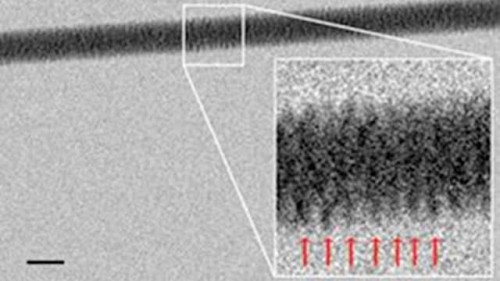Researchers have taken a photo of a DNA strand, which is kind of cool, but also confused me a bit. Here it is:
Wait. The link says that this photo reveals the familiar “spiralling corkscrew” of the DNA double helix, but that can’t be right. The familiar B-DNA form has a diameter of 2nm and the helices ought to show a 3.3nm repeat — this photo shows something way too thick and far too tightly wound to be a single strand. Also, every source I’ve found so far reproduces the photo with the scale bar but doesn’t tell us the size of that bar, which is really annoying.
I looked a little further elsewhere (I don’t have access to the journal it was published in, unfortunately) and found a slightly different story:
…at present, the method only works with “cords” of DNA made up of six molecules wrapped around an seventh acting as a core. That’s because the electron energies are high enough to break up a single DNA molecule.
Oops, yeah. That makes more sense. So sorry, you still haven’t seen a photograph of a single double-helical strand of DNA. But at least now you’ve seen many strands of DNA wrapped around a filament.
Here’s a much more detailed critique of the reporting on that paper.



Huh, weird. Going to the page for the paper now, they show the various figures, and the size of the scale bars are right next to them — now, at least.
http://pubs.acs.org/doi/abs/10.1021/nl3039162
For the image above, the scale bar is labeled “20nm”
It looks like one of those pictures from the 90s-00s where you had to look at it slightly unfocused in order for the “real” picture to appear.
…
Is that a dolphin?
20nm? Oh, that helps. Yeah, that’s WAY too thick to be a single strand of DNA, obviously.
Now the mystery is why the version distributed to press releases had the scale omitted…
I do remember reading in one of the articles, however, that the authors said they had recently had success getting images with lower-energy electrons, and that a picture of a single strand of DNA might not be too far off.
That might be my DNA. I’m pretty thick.
Wow, science journalism fail. The paper is titled: Direct Imaging of DNA Fibers: The Visage of Double Helix. The authors say in the title they aren’t looking at single strands of DNA
You can just see the Jesus in it.
Well, the IDiots will, anyhow.
Glen Davidson
IBM scientists have already imaged pentacene and larger buckball-ish molecules. SINGLE MOLECULES!eleventy!!!
they use AFM with a CO molecule on the tip that provides sub nanometer resolution. here is a link to an article about the technique:
http://www.bbc.co.uk/news/science-environment-19584301
someone ought to be able to image DNA.
Well I do, so neh!
They’re using lambda-DNA in A conformation. The spacing of the red arrows is 2.7 +/- 0.2 nm, which corresponds to the expected period.
Where possible, always take the time to point out to editors, journalists, and webmeisters when they’ve flubbed something because they don’t really understand this or that technical field. No one expects a reporter to understand, say, string theory, but at least have a sound grasp of basics like cause and effect, uncertainty in measurement, and so on.
Just the other day the BBC had a squib about some discovery or other and the text said (I paraphrase) “this allows scientists to guess the age of X”. I sent in a complaint about website inaccuracy, pointing out that the correct word would be estimate or calculate but certainly not “guess”, along with the semi-rhetorical question, don’t your reporters understand basic physics?
As the old saying has it, the squeaky wheel gets the grease, and the more such corrections a news organization receives, the more they will awaken to the fact that (a) people notice this kind of stupidity and (b) they don’t like it. Hence, it’s important to call news sources on such mistakes, as much as your time and inclinations allow.
Question: does anyone know of some public website, a sort of wall of shame, where such gaffes can be reported? As matters stand, it wouldn’t surprise me if the BBC just dropped my comment in the bit bucket. A public repository for reports of scientific stupidity in the media, short and sweet, would turn up the heat on editors to take more care in such matters.
I knew it was helixing at the wrong angle to be a single strand, but it took me a few to realize that was what PZ was saying. (Thanks mostly to seeing the DNA model in “The Big Bang Theory” TV show.)
My amazement is that they managed to make that cord.
Thanks to those of you who sent the paper.
The paper itself is just fine, and kind of neat in a geeky technical way. The problem is entirely in the reporting by secondary sources.
Menyambal
Yeah, it’s got the pitch of a machine screw.
It’s actually quite easy to image a single DNA molecule. You just make it fluorescent.
Of course, you can’t see the double helix though…
Yeah, no way in hell that’s a single molecule of dsDNA. I would remind PZ that it really isn’t best to refer to a single DNA molecule as a single strand, because it makes us virologists think that your talking about ssDNA. Anyway, I’ll bet you that the sample is in the A form anyway.
Damn you tpyos!!!!! you’re not your!
PZ: I’ve e-mailed you a PDF copy of the full text paper.
Damn, should have read the comments before clogging PZ’s mailbox with another copy of the paper. Sorry, squidly overlord!